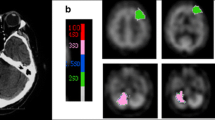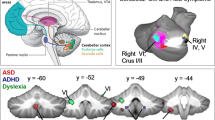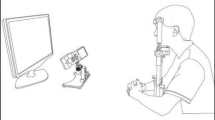Abstract
Children with developmental dyspraxia (DD) express impairments in the acquisition of various motor skills and in the development of their social cognition abilities. Although the neural bases of this condition are not fully understood, they are thought to involve frontal cortical areas, subcortical structures, and the cerebellum. Although cerebellar dysfunction is typically difficult to assess and quantify using traditional neurophysiological methods, oculomotor analysis may provide insight into specific cerebellar patterns. The aim of the present study was to investigate, in dyspraxic and typically developing subjects, various oculomotor saccade tasks specifically designed to reveal frontal and cerebellar dysfunction. In addition to evidence supporting prefrontal dysfunction, our results revealed increased variability of saccade accuracy consistent with cerebellar impairments. Furthermore, we found that dyspraxic patients showed decreased velocities of non-visually guided saccades. A closer analysis revealed significant differences in saccade velocity profiles with slightly decreased maximum saccade velocities but markedly prolonged deceleration phases. We show that this pattern was not related to a decreased state of alertness but was suggestive of cerebellar dysfunction. However, the clear predominance of this pattern in non-visually guided saccades warrants alternative hypotheses. In light of previous experimental and anatomical studies, we propose that this unusual pattern may be a consequence of impaired connections between frontal areas and cerebellar oculomotor structures.





Similar content being viewed by others
References
Vaivre-Douret L. Developmental coordination disorders: state of art. Neurophysiol Clin. 2014;44:13–23.
Vaivre-Drouet L, Lalanne C, Cabrol D, Ingster-Moati I, Falissard B, Golse B. Identification of diagnostic criteria of developmental coordination disorder (DCD) or developmental dyspraxia subtypes. Neurospychiatrie de l’Enfance et de l’Adolescence. 2011;59:443–53.
Vaivre-Drouet L, Lalanne C, Ingster-Moati I, et al. Subtypes of developmental dyspraxia and developmental coordination disorder (DCD): research on their nature and etiology. Dev Neuropsychol. 2011;36:1–29.
Xavier J, Tilmont E, Bonnot O. Children’s synchrony and rhythmicity in imitation of peers: toward a developmental model of empathy. J Physiol Paris. 2013;107:291–7.
Bo J, Lee CM. Motor skill learning in children with developmental coordination disorder. Res Dev Disabil. 2013;34:2047–55.
Kheradmand A, Zee DS. Cerebellum and ocular motor control. Front Neurol. 2011;2:1–15.
Langaas T, Mon-Williams M, Wann JP, Pascal E, Thompson C. Eye movements, prematurity and developmental co-ordination disorder. Vision Res. 1998;38:1817–26.
Lahuis BE, Van Engeland H, Cahn W, et al. Smooth pursuit eye movement (SPEM) in patients with multiple complex developmental disorder (MCDD), a subtype of the pervasive developmental disorder. World J Biol Psychiatry. 2009;10:905–12.
Robert MP, Ingster-Moati I, Albuisson E, Cabrol D, Golse B, Vaivre-Douret L. Vertical and horizontal smooth pursuit eye movements in children with developmental coordination disorder. Dev Med Child Neurol. 2014;56:595–600.
Gaymard B. Cortical and sub-cortical control of saccades and clinical application. Rev Neurol (Paris). 2012;168:734–40.
Quaia C, Lefèvre P, Optican LM. Model of the control of saccades by superior colliculus and cerebellum. J Neurophysiol. 1999;82:999–1018.
American Psychiatric Association. Diagnostic and statistical manual of mental disorders. 5th edn. Arlington, VA: American Psychiatric Publishing, 2013.
Henderson SE, Sugden DA. Movement assessment battery for children. London: Psychological Corporation; 1992.
Brannigan GG, Decker SL. The Bender-Gestalt II. Am J Orthopsychiatry. 2006;76:10–2.
Maslow P, Frostig M, Lefever DW, Whittlesey JR. The Marianne Frostig developmental test of visual perception, 1963 Standardization. Percept Mot Skills. 1964;19:463–99.
Blote AW, Hamstra-Bletz L. A longitudinal study on the structure of handwriting. Percept Motor Skills. 1991;72:983–94.
Wechsler D. Wechsler intelligence scale for children—fourth edition (WISC-IV). San Antonio, TX: The Psychological Corporation; 2003.
Wechsler D. Wechsler adult intelligence scale—fourth edition (WAIS–IV). San Antonio, TX: NCS Pearson; 2008.
Smit AC, Van Gisbergen JA, Cools AR. A parametric analysis of human saccades in different experimental paradigms. Vision Res. 1987;27:1745–62.
Crawford JR, Garthwaite PH. Investigation of the single case in neuropsychology: confidence limits on the abnormality of test scores and test score differences. Neuropsychologia. 2002;40:1196–208.
Crawford JR, Howell DC. Comparing an individual’s test score against norms derived from small samples. Clin Neuropsychol. 1998;12:482–86.
Leigh RJ, Kennard C. Using saccades as a research tool in the clinical neurosciences. Brain. 2004;127:460–77.
Gaymard B, Pierrot-Deseilligny C. Neurology of saccades and smooth pursuit. Curr Opin Neurol. 1999;12:13–9.
Ploner CJ, Gaymard BM, Rivaud-Péchoux S, Pierrot-Deseilligny C. The prefrontal substrate of reflexive saccade inhibition in humans. Biol Psychiatry. 2005;57:1159–65.
Pierrot-Deseilligny C, Müri RM, Ploner CJ, Gaymard B, Demeret S, Rivaud-Pechoux S. Decisional role of the dorsolateral prefrontal cortex in ocular motor behaviour. Brain. 2003;126:1460–73.
Hikosaka O, Takikawa Y, Kawagoe R. Role of the basal ganglia in the control of purposive saccadic eye movements. Physiol Rev. 2000;80:953–78.
Munoz DP, Dorris MC, Paré M, Everling S. On your mark, get set: brainstem circuitry underlying saccadic initiation. Can J Physiol Pharmacol. 2000;78:934–44.
Dias EC, Segraves MA. Muscimol-induced inactivation of monkey frontal eye field: effects on visually and memory-guided saccades. J Neurophysiol. 1999;81:2191–214.
Sommer MA, Tehovnik EJ. Reversible inactivation of macaque dorsomedial frontal cortex: effects on saccades and fixations. Exp Brain Res. 1999;124:429–46.
Pierrot-Deseilligny C, Rivaud S, Gaymard B, Agid Y. Cortical control of reflexive visually-guided saccades. Brain. 1991;114:1473–85.
Condy C, Rivaud-Péchoux S, Ostendorf F, Ploner CJ, Gaymard B. Neural substrate of antisaccades: role of subcortical structures. Neurology. 2004;63:1571–8.
Kojima Y, Soetedjo R, Fuchs AF. Behavior of the oculomotor vermis for five different types of saccade. J Neurophysiol. 2010;104:3667–76.
Ohtsuka K, Noda H. Burst discharges of fastigial neurons in macaque monkeys are driven by vision- and memory-guided saccades but not by spontaneous saccades. Neurosci Res. 1992;15:224–8.
Ron S, Robinson DA. Eye movements evoked by cerebellar stimulation in the alert monkey. J Neurophysiol. 1973;36:1004–22.
Ohki M, Kitazawa H, Hiramatsu T, et al. Role of primate cerebellar hemisphere in voluntary eye movement control revealed by lesion effects. J Neurophysiol. 2009;101:934–47.
Gaymard B, Ploner CJ, Rivaud-Péchoux S, Pierrot-Deseilligny C. The frontal eye field is involved in spatial short-term memory but not in reflexive saccade inhibition. Exp Brain Res. 1999;129:288–301.
Rivaud S, Müri RM, Gaymard B, Vermersch AI, Pierrot-Deseilligny C. Eye movement disorders after frontal eye field lesions in humans. Exp Brain Res. 1994;102:110–20.
Peel TR, Johnston K, Lomber SG, Corneil BD. Bilateral saccadic deficits following large and reversible inactivation of unilateral frontal eye field. J Neurophysiol. 2014;111:415–33.
Thier P, Möck M. The oculomotor role of the pontine nuclei and the nucleus reticularis tegmenti pontis. Prog Brain Res. 2006;151:293–320.
Kaneko CR, Fuchs AF. Effect of pharmacological inactivation of nucleus reticularis tegmenti pontis on saccadic eye movements in the monkey. J Neurophysiol. 2006;95:3698–711.
Becker EB, Stoodley CJ. Autism spectrum disorder and the cerebellum. Int Rev Neurobiol. 2013;1(113):1–34.
Courchesne E, Mouton PR, Calhoun ME, et al. Neuron number and size in prefrontal cortex of children with autism. JAMA. 2011;306:2001–10.
Bernard JA, Mittal VA, 160.10. Cerebellar-motor dysfunction in schizophrenia and psychosis-risk: the importance of regional cerebellar analysis approaches. Front Psychiatry. 2014;5(160.10):3389.
Phillips JR, Hewedi DH, Eissa AM, Moustafa AA. The cerebellum and psychiatric disorders. Frontiers in public health. 2015;34. Doi:10.1016/B978-0-12-418700-9.000011-0
Stoodley CJ. Distinct regions of the cerebellum show gray matter decreases in autism, ADHD, and developmental dyslexia. Distributed Networks-New Outlooks on Cerebellar Function. 2015 3:89
Hodge SM, Makris N, Kennedy DN, et al. Cerebellum, language, and cognition in autism and specific language impairment. J Autism Dev Disord. 2010;1(40):300–16.
Manto MU, Jissendi P. Cerebellum: links between development, developmental disorders and motor learning. Frontiers in Neuroanatomy. 2012 6 1.10.3389/fnana.2012.0000
Schmitt LM, Cook EH, Sweeney JA, Mosconi MW. Saccadic eye movement abnormalities in autism spectrum disorder indicate dysfunctions in cerebellum and brainstem. Mol Autism. 2014;5:47.
Cui H, Liu XH, Wang KY, Zhu CY, Wang C, Xie XH. Association of saccade duration and saccade acceleration/deceleration asymmetry during visually guided saccade in schizophrenia patients. PLoS One. 2014;9(5):e97308.
Gurvich CT, Fitzgerald PB, Georgiou-Karistianis N, White OB. Saccadic impairment in schizophrenia with prominent negative symptoms. Neuroreport. 2008;19:1435–9.
Author information
Authors and Affiliations
Corresponding author
Ethics declarations
Conflict of Interest
The authors disclose any financial or commercial conflict of interest with this article.
Rights and permissions
About this article
Cite this article
Gaymard, B., Giannitelli, M., Challes, G. et al. Oculomotor Impairments in Developmental Dyspraxia. Cerebellum 16, 411–420 (2017). https://doi.org/10.1007/s12311-016-0817-6
Published:
Issue Date:
DOI: https://doi.org/10.1007/s12311-016-0817-6




